|
The history of the dirty bomb has yet to be written, because
fortunately no one to date has ever deployed a conventional
explosive laced with radioactive material. However, a slew of
worrisome incidents in several countries involving loose or orphaned
radioactive devices forms a chilling chronology and a stark reminder
that a dirty bomb could explode tomorrow anywhere in the world.
Terrorist groups are actively pursuing unsecured radiological
material, and several of them may already possess dirty-bomb
capabilities. In this timeline, review the past 15 years of
news-making incidents involving unprotected radioactive materials
worldwide, including many occurrences of accidental encounters that
prove just how easy it is to acquire these dangerous substances.
 September 1987
September 1987

|
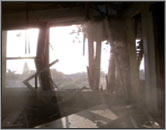
The destruction of a contaminated Goiaina home
|
|
Goiaina, Brazil—A scrap-yard worker pries open a
lead canister that was scavenged from an abandoned cancer
treatment center and dumped at the yard five days earlier.
Inside the canister the man is delighted to find a sparkling
blue powder; he has no idea the powder is radioactive cesium.
Curious residents living near the junkyard pass the canister
from home to home for nearly a week. All told more than 200
people are exposed to the cesium. The incident—a
radiation disaster second only to Chernobyl in size and
scope—causes the deaths of four people, including a
six-year-old girl who rubbed the powder over her body and hair
so that she glowed. The radioactivity contaminates soil,
businesses, and homes, 85 of which are leveled during the
cleanup process.
|
 November 1995
November 1995

|

The cesium-filled package uncovered in a Moscow park
|
|
Moscow, Russia—In the first-ever attempt at
radiological terror, a group of Chechen rebels contacts a
Russian television station and boasts of its ability to
construct a radioactive bomb. The rebels alert the press that
they have buried a cache of radiological materials in Moscow's
Ismailovsky Park. In the very spot where the rebels indicated
it would be, authorities find a partially buried container of
cesium. Neither the Chechens who planted it there nor the
original source of the cesium are ever identified.
|
 March 1998
March 1998

|
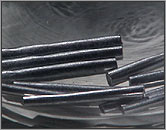
Cesium tubes similar to the ones missing from Greensboro
|
|
Greensboro, North Carolina—Nineteen small tubes
of cesium go missing from a locked safe in Moses Cone Memorial
Hospital. Each only three-quarters of an inch long by
one-eighth of an inch wide, the tubes were being stored for
use in the treatment of cervical cancer. Though local, state,
and federal officials scour the city using sophisticated
radiation-sensing equipment, the cesium is never recovered.
Authorities believe whoever stole the cesium tubes—for
the loss is officially listed as a theft—may have been
trained to handle the material, since unprotected contact with
the tubes could have caused serious injury or even death.
After the loss, the hospital takes steps to better secure its
nuclear assets.
|
 December 1998
December 1998

|
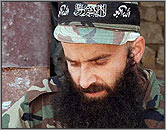
Shamil Basayev, Chechen rebel leader
|
|
Argun, Chechnya—The head of the Russian-backed
Chechen Security Service, Ibragim Khultygov, announces that a
Security Service team has found a container filled with
radioactive materials and attached to an explosive mine hidden
near a railway line. They safely defuse the bomb but do not
identify the radioactive substances involved. The location of
the discovery—in a suburban area 10 miles east of the
Chechen capital of Grozny, where a Chechen rebel group is
known to operate an explosives workshop—leads nuclear
specialists to suspect Chechen rebels' involvement in the
incident. Shamil Basayev, the rebel leader who phoned in the
dirty-bomb threat in Moscow three years earlier, is the known
chief of the explosives workshop near Argun.
|
 September 1999
September 1999

|
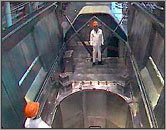
Inside the Radon Special Combine in the Chechen capital
|
|
Grozny, Chechnya—Unidentified thieves attempt to
steal a container of radioactive materials from the Radon
Special Combine chemical factory. Half an hour after being
exposed to the container, one of the suspects dies and the
other collapses, even though each held the container for only
a few minutes while trying to carry it out of the factory. The
surviving suspect is hospitalized in critical condition, but
he recovers and is placed under arrest. Chechen officials do
not discuss his case publicly, nor do they identify the type
of radioactivity involved in the incident, saying only that
the container held 200 grams of "radioactive elements."
|
 June 2001
June 2001

|
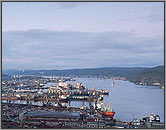
Russia's Murmansk coastal region, which is studded with
unsecured nuclear lighthouses
|
|
Kandalaksha, Russia—Two people in Russia's
Murmansk region receive powerful doses of radioactivity and
are hospitalized after plundering a nuclear-powered
lighthouse, one of 132 such lighthouses located along Russia's
northern coast. The scavengers say they were trying to extract
lead from the lighthouse for sale as scrap metal and were
unaware of its dangerous strontium power source. Inspectors
later detect elevated radiation levels for hundreds of feet on
the route along which the two carried a leaking lead container
before abandoning it. Though Russia's Soviet-era nuclear
lighthouses were originally designed to withstand earthquakes
and even planes crashing into them, after years of neglect
these unguarded and uninspected structures are easily
dismantled by thieves. In January 2003, the U.S. government
announces a plan to aid Russia in safely replacing the energy
sources of all of its nuclear lighthouses.
|
 December 2001
December 2001

|

The Georgia radioactive device and its containment bucket with
handles
|
|
Lja, Georgia—Three woodcutters discover two
heat-emanating containers near their campsite in the remote
Abkhazia region of the Caucasus. Hoping to use the containers
as a heat source, the men drag them back to their tents.
Within hours they become ill with nausea, vomiting, and
dizziness, and leave the site to seek treatment at a local
hospital. Later, the men develop severe radiation burns on
their backs. The International Atomic Energy Agency (IAEA)
dispatches a team to recover the containers, but severe
weather prevents them for more than a month from reaching the
campsite and securing the materials. When the IAEA team
finally reaches the containers in February 2002, they discover
that each one, previously used in Soviet-era radiothermal
generators, contains 40,000 curies of strontium, an amount of
radiation equivalent to that released immediately after the
accident at Chernobyl.
|
 June 2002
June 2002

|
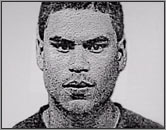
Jose Padilla, who allegedly intended to explode a dirty bomb
in the U.S.
|
|
Chicago, Illinois—Jose Padilla, an American
citizen and former Chicago gang member with known ties to Al
Qaeda, is arrested in Chicago's O'Hare airport on suspicion of
planning to build and detonate a dirty bomb in an American
city. F.B.I agents suspect Padilla has recently undergone
training in Lahore, Pakistan, where he allegedly studied the
mechanics of dirty-bomb construction, including how to wire
explosive devices and how to optimize bombs for radiological
dispersion. Officials believe Padilla, who arrived in the U.S.
carrying a suitcase packed with $10,000 in cash, was on a
reconaissance mission for a future dirty-bomb attack. Padilla
is being held as an "enemy combatant" in a military brig and
may be detained indefinitely.
|
 November 2002
November 2002

|
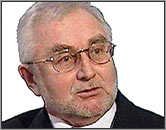
Yuri Vishnyevsky, the head of Russia's nuclear regulatory
agency
|
|
Moscow, Russia—The head of Russia's nuclear
regulatory agency, Yuri Vishnyevsky, announces that small
amounts—a few grams here and there—of
weapons-grade and reactor-grade nuclear materials are missing
from the country's atomic facilities. Vishnyevsky does not
provide details on when and how the materials disappeared, but
he indicates that the material involved is uranium. According
to experts, a few grams of weapons-grade uranium would not be
sufficient to make an effective nuclear bomb, but it could
provide material adequate for a dirty bomb. Moreover, small
amounts of reactor-grade uranium can be enriched to
weapons-grade through a process that some rogue nations
possess, including Iraq. With Russia's nuclear security in
severe decline due to financial troubles and disorganization,
Vishnyevsky's announcement underscores a major source of
concern about unsecured radioactive materials in Russia.
|
 January 2003
January 2003

|
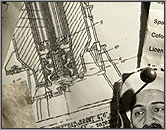
A collage of dirty bomb plans journalists recently discovered
in Afghanistan
|
|
Herat, Afghanistan—Based on evidence uncovered in
Herat, including detailed diagrams and documents stored on
computers, British intelligence agents and weapons researchers
conclude that Al Qaeda has succeeded in constructing a small
dirty bomb, though the device has not been found. Officials do
not know how much radiation the dirty bomb could spread, but
they suspect that Afghanistan's Taliban regime helped Al Qaeda
build the device by providing radioactive sources from medical
devices. Furthermore, Abu Zubaydah, the captured Al Qaeda
lieutenant now in American custody, told interrogators that
such a device existed. In Kabul, in April 2002, IAEA experts
secured several powerful unguarded radiation sources, mainly
cobalt, once used in medical and research applications.
|

|
|

